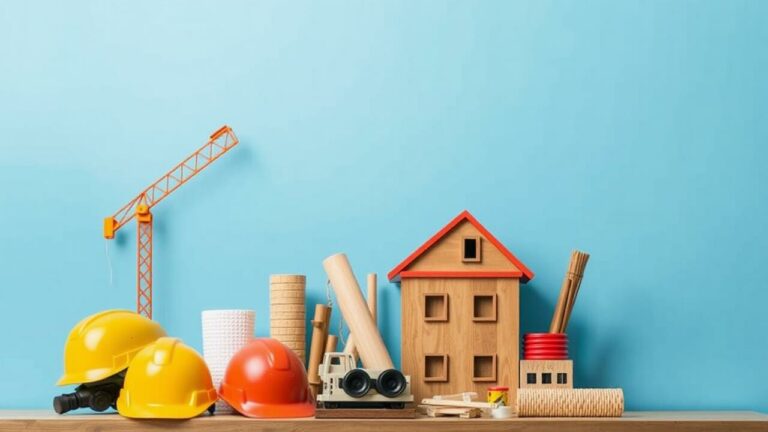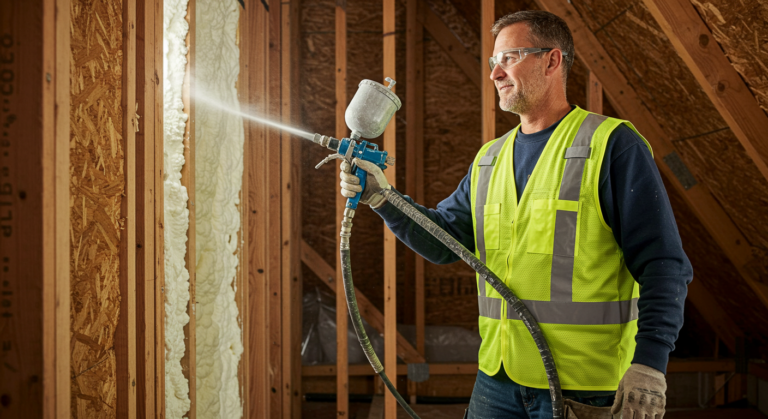Table Of Contents
Discover the Top Green Building Materials for Construction Projects
Key Takeaways
- Summary of eco-conscious construction elements and their significance.
- Leading sustainable materials ideal for building endeavors.
- Environmentally friendly insulation choices available for projects.
- Renewable flooring options that promote sustainability.
- Eco-conscious materials that enhance energy performance.
- Guidelines for selecting optimal sustainable resources for building.
Overview of Green Building Materials
The demand for green building materials has surged as sustainability in construction becomes a priority for architects and builders. This shift reflects the broader movement toward green construction, where environmentally responsible practices take center stage. Top green building materials for construction projects, such as bamboo, recycled steel, and straw bales, exemplify innovative choices that support both ecological and structural integrity. Organizations like the US Green Building Council advocate for these practices, promoting standards that enhance energy efficiency and reduce the carbon footprint of buildings. Integration of features like green roofs not only contributes to aesthetic value but also improves insulation and biodiversity in urban environments. Embracing these building materials is essential for creating sustainable and resilient green buildings.
Importance of Sustainable Practices in Construction
Sustainable construction practices play a crucial role in minimizing the environmental footprint of building projects. By prioritizing renewable materials and energy-efficient designs, builders can create well-insulated buildings that consume less energy. Utilizing top green building materials for construction projects, such as structural insulation panels and recycled roofing materials, helps in reducing waste and promotes greener construction methods. Incorporating eco-friendly building supplies not only enhances a project’s sustainability but also boosts its long-term viability.
The adoption of green technology in construction leads to significant benefits both for the environment and for building occupants. For instance, using concrete slabs with high thermal mass or roofing tiles designed for energy efficiency can improve a building’s overall performance. A focus on sustainable building practices ensures that projects are not only aesthetically appealing but also resilient over time. The combination of carefully selected insulation material and innovative designs contributes to the creation of homes and offices that are both functional and environmentally responsible.
| Practice | Description | Benefits |
|---|---|---|
| Use of Renewable Materials | Incorporating materials like bamboo, reclaimed wood, and recycled metal in construction. | Reduces waste and resource depletion; promotes circular economy. |
| Energy-Efficient Designs | Designs that maximize natural light and ventilation while minimizing heating and cooling needs. | Lower energy consumption and utility costs for occupants. |
| Green Roofing Systems | Installing roofs with vegetation that provide insulation and absorb rainwater. | Improved building performance and reduction in urban heat island effect. |
| Water Conservation Techniques | Implementing rainwater harvesting systems and low-flow fixtures. | Reduced water consumption and stormwater runoff. |
Benefits of Utilizing Green Building Materials
The incorporation of top green building materials for construction projects promotes a healthier environment and reduces the ecological footprint of the construction sector. Utilizing materials such as recycled materials, structural insulated panels, and 3D-printed concrete leads to significant energy savings and improved resource efficiency. The use of concrete blocks and reinforced concrete can be optimized through sustainable design practices, ensuring that structures not only meet environmental standards but also serve as beneficial green spaces for communities.
Green building materials, such as roof tiles made from recycled resources, enhance durability while minimizing waste. Earth structures and innovative materials like bamboo contribute to energy-efficient designs that lower utility costs and improve indoor air quality. Embracing these top green building materials for construction projects fosters a commitment to sustainability that can inspire future developments across the architecture and construction sectors.
Top Green Building Materials for Construction Projects
In the realm of Top Green Building Materials for Construction Projects, a variety of innovative materials play a crucial role in enhancing sustainability and efficiency. Architects and construction workers are increasingly turning to ready-mix concrete and recycled concrete as environmentally friendly alternatives that reduce construction waste. Roof insulation options, including insulating concrete forms (ICFs), provide effective thermal performance while maintaining structural integrity. Straw bale construction remains a popular choice for its exceptional insulating properties and use of renewable materials. Bricks made from recycled content also contribute to sustainable building practices, making them a versatile option for both roofing and wall applications. Emphasizing these materials supports the transition towards eco-friendly construction strategies.
Bamboo as a Sustainable Building Material
Bamboo has emerged as one of the top green building materials for construction projects, appealing to architects and builders focused on sustainable architecture. This fast-growing grass thrives in numerous environments and can reach maturity within three to five years, making it an excellent source of sustainable building materials. Its strength-to-weight ratio rivals that of traditional timber, while its flexibility allows for innovative design possibilities in green building projects. As the green building scene evolves, integrating bamboo into sustainable construction materials has become an essential practice for eco-conscious professionals.
Selecting bamboo as a primary material for green building activity supports environmentally friendly practices. Bamboo requires fewer resources and minimal chemical treatments compared to other conventional building materials. Its ability to sequester carbon during growth contributes to reduced greenhouse gas emissions, making it a vital component in combating climate change. As awareness around environmentally responsible choices increases, incorporating bamboo into construction aligns with the vision of future-focused, sustainable building materials that leave a positive impact on the planet.
- Bamboo is a renewable resource that can be harvested sustainably without damaging the environment.
- It has excellent thermal and acoustic insulation properties, making buildings more energy-efficient.
- The versatility of bamboo allows it to be used for various applications, from structural components to decorative elements.
- Bamboo grows rapidly, allowing for quicker project turnaround times as compared to traditional timber.
- Its lightweight nature reduces transportation costs and simplifies construction logistics.
- Using bamboo can enhance aesthetic appeal, offering a unique and natural look to buildings.
- Incorporating bamboo in construction can contribute to green building certifications, showcasing commitment to sustainability.
Recycled Steel: Strength and Sustainability
Recycled steel stands out as one of the top green building materials for construction projects due to its strength and sustainability. This sustainable building material is produced from scrap metal, significantly reducing the need for virgin materials. Compared to conventional building materials, recycled steel offers enhanced durability and can withstand harsh conditions, making it a popular choice among eco-friendly construction materials. Its use in various structural applications exemplifies how different construction materials can contribute to greener construction practices while maintaining high performance.
The advantages of recycled steel extend beyond its structural properties. This green material is also economical, allowing builders to reduce costs while adhering to sustainable construction practices. With the rise in demand for plant-based building materials and renewable building materials, recycled steel aligns perfectly with the growing trend toward friendly building materials. As builders seek innovative solutions, integrating recycled steel into construction projects not only promotes sustainability but also enhances overall energy efficiency, solidifying its place as a key player among the top green building materials for construction projects.
Straw Bale Construction: Insulating Efficiency
Straw bale construction emerges as one of the top green building materials for construction projects due to its remarkable insulating efficiency. This eco-friendly building material offers high thermal performance, making it a popular building material for both new building projects and green renovations. Its lightweight nature allows for easy handling by materials contractors, thereby reducing transportation costs and energy consumption. By incorporating straw bales into modern building projects, homeowners can significantly lower their ecological footprint while benefiting from enhanced energy efficiency.
This innovative approach aligns with green roof technology, promoting sustainability within the entire structure. Straw bales serve as an excellent alternative to conventional construction materials, proving that eco-friendly building materials can match or exceed the performance of traditional options. As awareness of environmental challenges increases, builders and homeowners alike are recognizing the advantages of utilizing straw bales in construction projects. They represent a wise choice for anyone looking to prioritize sustainability without compromising on comfort and design.
EcoFriendly Insulation Options
The use of eco-friendly insulation options has become essential in achieving green building aspirations. Among the top green building materials for construction projects, cellulose insulation stands out due to its effectiveness and use of recycled building materials. Mushrooms-based building materials are innovative options that showcase the potential of natural resources in eco-friendly construction material. As new construction projects emerge, integrating insulating solutions like cork insulation enhances the performance of building structures while contributing to sustainability efforts. With green roof installations becoming more popular, the impact of these eco-friendly building projects extends beyond insulation to overall energy efficiency. The combination of these revolutionary building materials helps ensure that construction not only meets current needs but also protects the environment for future generations.
Cellulose Insulation: Benefits and Applications
Cellulose insulation stands out as one of the top green building materials for construction projects due to its eco-friendly properties. Made primarily from recycled paper products, cellulose insulation aligns with sustainable building practices by reducing waste and reliance on traditional construction materials. This form of insulation is not only effective in providing thermal resistance but also in contributing to the overall energy efficiency of concrete constructions. For those considering sustainable materials for their next construction project, cellulose insulation presents a viable option that supports the green building movement.
The applications of cellulose insulation extend beyond mere thermal performance. It is often used in the walls and attics of buildings, enhancing the energy efficiency of green roofs. This sustainable building product acts as a sound deterrent and helps regulate indoor temperatures, aiding in the reduction of energy costs. Utilizing cellulose insulation as a valuable building component can significantly impact the sustainability of both residential and commercial structures, reinforcing the importance of integrating eco-friendly solutions in the construction industry.
Cork Insulation: An Innovative Choice
Cork insulation is emerging as one of the Top Green Building Materials for Construction Projects due to its unique properties and sustainable origins. Derived from the bark of cork oak trees, this reliable construction material offers excellent thermal and acoustic insulation, making it suitable for various construction applications. It can be seamlessly integrated into reinforced concrete buildings, providing additional energy efficiency without compromising the structural integrity of concrete structures. The use of cork aligns with sustainable construction methods, contributing to reduced environmental impacts in concrete manufacturing.
With its natural resistance to mold and pests, cork is ideal for outdoor construction projects, particularly in green roof installations. The green roof benefits extend beyond aesthetics, as cork insulation enhances green roof energy performance by regulating temperature fluctuations. Its lightweight nature allows for easy handling during building material rescues, making it a practical choice alongside several materials in eco-friendly designs. By selecting cork, builders can meet the growing demand for sustainability in construction without sacrificing performance or reliability.
Sustainable Flooring Materials
The choice of flooring materials plays a significant role in advancing greener projects within home construction. Eco-friendly building techniques focus on using sustainable materials, significantly reducing the environmental footprint of construction purposes. Among the top green building materials for construction projects, salvaged wood stands out for its unique aesthetic and minimal impact on forests, while options like sustainable tile and stone provide durability and beauty. Builders often favor these structural materials due to their ability to enhance various construction applications. Unlike traditional flooring options, which may involve human-made insulating materials or plastic roofing tiles, these sustainable alternatives support energy efficiency and contribute to the overall success of construction techniques tailored toward environmental responsibility. Choosing responsible products ensures that construction pros can meet the demand for eco-conscious living spaces.
Use of Salvaged Wood in Construction
Salvaged wood has gained recognition as one of the top green building materials for construction projects due to its environmental benefits and aesthetic appeal. Utilizing reclaimed timber reduces the demand for new materials, which helps to preserve natural resources. This sustainable material fits perfectly into various building applications, from framing and flooring to unique design elements in modern homes. Innovative construction techniques are employed to ensure that salvaged wood meets current safety and durability standards, making it a suitable choice for both residential and commercial builds.
The use of salvaged wood not only contributes to sustainable building solutions but also adds character to construction sites. As the construction industry increasingly embraces eco-friendly practices, architects and builders are exploring new materials with a focus on minimizing environmental impact. Salvaged wood can be particularly advantageous in projects that incorporate energy-efficient designs, such as bale construction. Its versatility allows for creative uses in constructing everything from durable roof tiles to intricate cabinetry, making it a go-to material for sustainable building methods.
- Reduces landfill waste by repurposing old materials.
- Adds unique character and history to new constructions.
- Offers a variety of textures, colors, and finishes for design flexibility.
- Supports local economies by sourcing materials from nearby structures.
- Can provide better insulation properties than new lumber in some cases.
- Encourages sustainable practices in the construction industry.
- Promotes the use of environmentally friendly finishes and treatments.
Options for Sustainable Tile and Stone
Sustainable tile and stone options are among the top green building materials for construction projects. These materials not only contribute to the aesthetic appeal of a space but also align with green principles essential for modern construction. Fire-resistant building materials like ceramic tiles and stone can enhance safety while ensuring durability, making them ideal choices for home construction today. Using such worthy materials enables builders to create sturdy structures that stand the test of time, incorporating earth construction techniques that emphasize sustainability.
Rubber masonry blocks offer a unique solution for flooring, providing an eco-friendly alternative to traditional materials. Their flexibility and durability make them a popular choice among building pros focused on implementing green construction practices. Sustainable tile options, sourced from recycled or natural materials, help reduce waste and promote energy efficiency. By prioritizing these top green building materials for construction projects, homeowners and builders alike can ensure that they are building homes that not only look good but also contribute positively to the environment.
Green Building Materials for Energy Efficiency
Energy efficiency in the construction world has become a critical focus, leading to the integration of top green building materials for construction projects. Using local materials not only supports regional economies but also reduces transportation emissions, making eco-friendly construction more viable. Concrete buildings benefit from innovations like energy-efficient windows, which enhance thermal performance and reduce heating and cooling costs. Projects involving new building or refurbishment benefit greatly from eco-friendly insulation materials, such as cellulose or cork, which improve overall energy efficiency. These practices encourage sustainable home building and outdoor structures that prioritize environmental responsibility, aligning with the goals of cement makers who are shifting towards greener alternatives in their production techniques.
Solar Panels: Integrating Renewable Energy
Solar energy has emerged as one of the top green building materials for construction projects, providing an eco-friendly solution that aligns with responsible construction practices. These systems can be integrated into building frames and wall panels for optimal efficiency. By utilizing solar panels, builders create sturdy walls that can harness renewable energy, significantly reducing reliance on traditional power sources. This sustainable design element not only benefits residential properties but also plays a vital role in commercial construction, contributing to energy independence.
Choosing solar panels as a part of the architectural design involves selecting simple materials that enhance overall sustainability. Builders who prioritize eco-friendly materials find that integrating these panels can positively impact construction jobs and the local economy. By embracing such innovations, construction teams can fulfill their commitment to sustainable development. Investing in solar energy not only advances individual projects but also sets a precedent for future endeavors in the realm of construction.
EnergyEfficient Windows: Enhancing Thermal Performance
Energy-efficient windows play a crucial role in enhancing the thermal performance of both new and renovated buildings. They serve as a barrier against outdoor temperature fluctuations, significantly reducing the need for mechanical heating and cooling systems. This contributes to achieving eco-friendly goals in upscale projects where design-build practices are prioritized. By incorporating sustainable cement varieties and true materials, young architects can align their designs with the principles of energy conservation. The integration of energy-efficient windows also complements other top green building materials for construction projects, such as wall insulation and wall tiles, creating a cohesive and effective environmental strategy.
The choice of windows can greatly impact the overall energy efficiency of a structure. High-performance glazing and advanced framing techniques are essential in minimizing heat loss and gain, therefore enhancing the indoor climate. As construction dates progress and innovative methods such as concrete printing become more prevalent, the importance of energy-efficient windows becomes more pronounced. By selecting these top green building materials for construction projects, builders can create spaces that not only meet aesthetic standards but also prioritize sustainability. This focus on efficient design promotes a healthier environment and reflects the ongoing commitment to environmentally responsible building practices.
Choosing the Best Sustainable Materials for Construction
Selecting the most suitable sustainable materials for construction requires an understanding of the evolving landscape of eco-friendly options. Top green building materials for construction projects now include innovative materials that enhance durability while reducing environmental impact. For instance, concrete tends to be reimagined through the use of recyclable concrete, which provides a concrete-like shape without the heavy carbon footprint. Construction teams increasingly prioritize reusable insulation materials that maintain energy efficiency, especially in the context of old builds undergoing renovation. This thoughtful selection supports a construction job that not only meets modern needs but also aligns with sustainability goals, ensuring that every choice contributes to a greener future.
| Material | Type | Environmental Impact | Benefits |
|---|---|---|---|
| Recycled Concrete | Aggregate | Reduces landfill waste | Lower carbon footprint, high durability |
| Bamboo | Natural Fiber | Fast-growing renewable resource | Strong, lightweight, and biodegradable |
| Reclaimed Wood | Timber | Minimizes deforestation | Unique aesthetic, rich character, carbon storage |
| Hempcrete | Insulation | Low embodied energy | Excellent thermal performance, mold-resistant |
| Sheep’s Wool Insulation | Insulation | Biodegradable | Great thermal regulation, reduces energy costs |
Conclusion
The green building movement has significantly influenced the construction industry by introducing sustainable materials that replace traditional construction materials. Top green building materials for construction projects, such as bamboo, recycled steel, and straw bales, showcase the shift towards sustainable building practices. The use of green roofs provides eco-friendly solutions that improve energy efficiency while enhancing urban aesthetics. As the demand for sustainable construction rises, incorporating valuable building components like energy-efficient windows and innovative insulation options becomes essential for any next construction project. Emphasizing green manufacturing processes ensures that sustainable building products contribute positively to the environment, making them crucial for concrete constructions and beyond. Embracing these sustainable materials not only fosters eco-friendly practices but also paves the way for a greener future in the construction industry.
FAQS
What are some examples of sustainable building materials that can be utilized in construction projects?
Sustainable building materials include a variety of options that promote greener construction practices. For instance, eco-friendly building materials such as wood-based material, mushroom-based building materials, and lightweight building material are excellent choices for ensuring durable walls in a building. Additionally, green roofs act as both insulating mechanisms and areas for urban greening. For refurbishment projects, using right building materials can better align with certain construction practices that prioritize sustainability, making them economical building materials in the long run. Young architects program participants are increasingly learning about these exciting construction techniques to incorporate into their designs.
How can incorporating green materials enhance the sustainability of construction projects?
Incorporating green materials not only promotes greener construction materials but also ensures the use of eco friendly building materials that contribute to a sustainable building isn. By wisely choosing construction materials, builders can create a green demonstration building that sets an example for future projects. Additionally, these practices can improve the quality of building blocks and facilitate road building and building bridges that align with eco-conscious design•build principles.
What strategies can be implemented to choose wisely construction materials for eco-friendly building practices?
To choose wisely construction materials for eco-friendly building practices, it’s essential to prioritize materials that have a low environmental impact, such as recycled, renewable, or locally sourced options. Conducting an assessment of the lifecycle of various materials can help ensure sustainability during the construction phase and beyond.
How can project managers ensure that they are using the best green building materials in their construction projects?
Project managers can ensure the selection of the best green building materials by researching eco-friendly options, engaging with suppliers that focus on sustainability, and comparing the life cycle impacts of various materials to make informed choices in their construction projects.
What are the benefits of using top green building materials in construction projects?
Using top green building materials in construction projects offers numerous benefits, including reduced environmental impact, improved energy efficiency, enhanced indoor air quality, and increased property value. These materials often contribute to sustainable design and promote healthier living and working environments.






